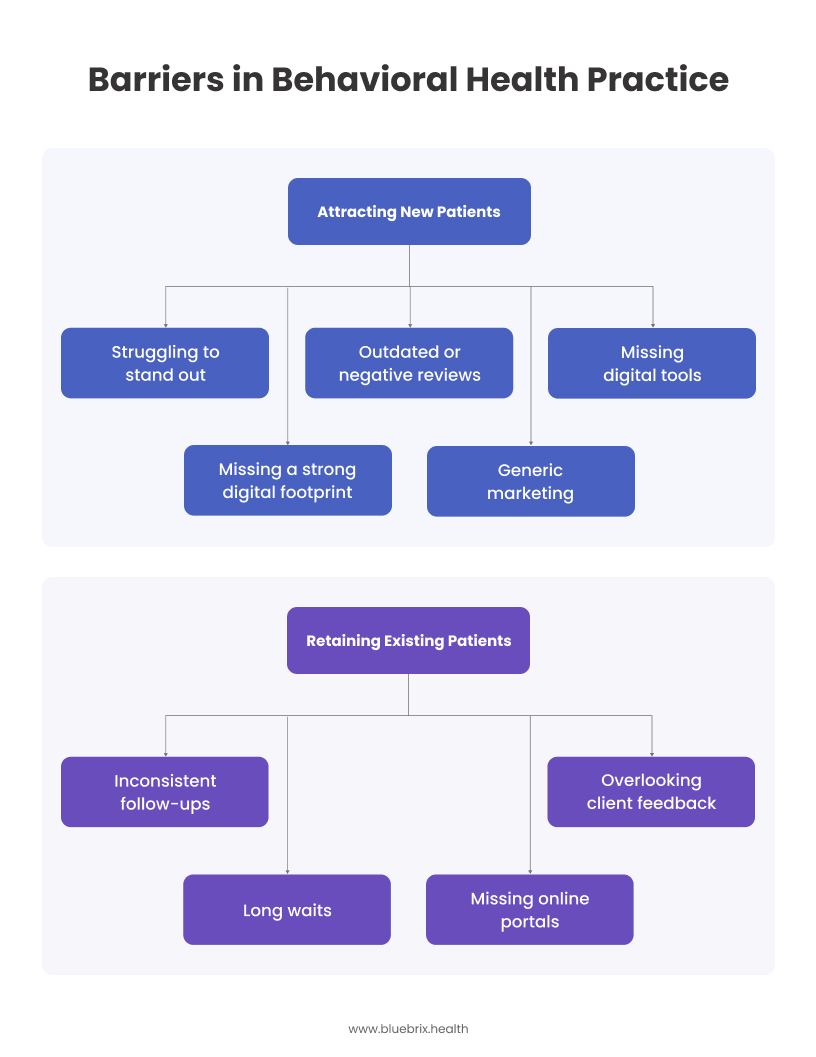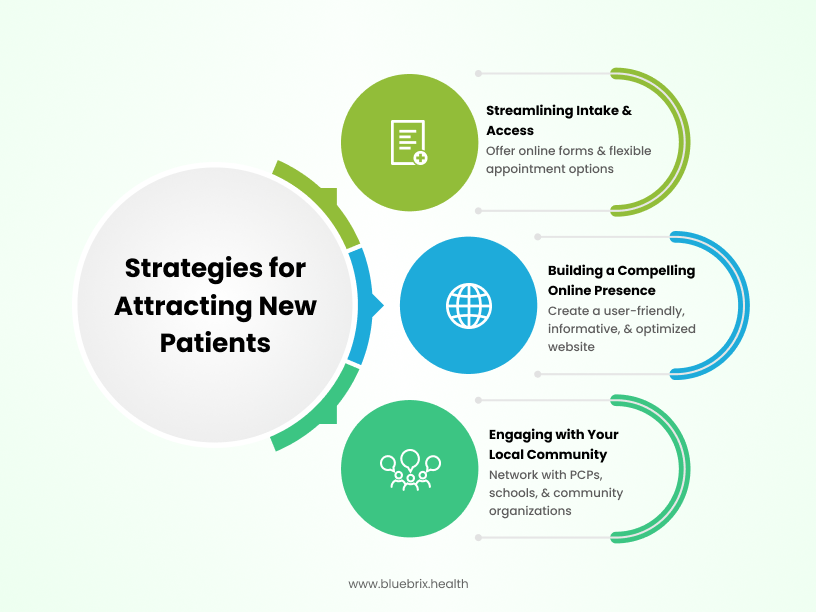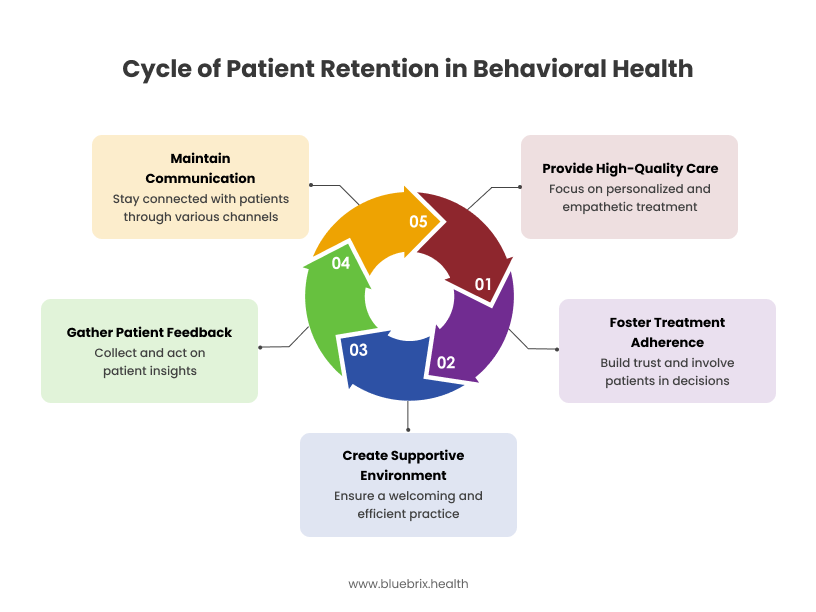Whether you're a solo provider or managing a multi-location clinic, building patient trust starts with the very first contact. And keeping that trust is what brings them back when they need support. In this blog, we’ll walk through practical ways to fill your schedule, keep patients engaged, and create a smooth care experience they’ll value.

According to a 2023 report from the National Council for Mental Wellbeing, 56% of behavioral health patients cited long wait times or difficulty getting an appointment as a reason for discontinuing care. On the other hand, practices that prioritize seamless access and strong follow-up can reduce dropout rates by nearly 40%. This underscores a key truth: growth isn’t only about marketing—it’s about optimizing patient experience from the first click to the final session.
In this blog, we’ll explore a dual approach to growth—how to attract new behavioral health patients through strategic visibility, digital presence, and community partnerships, and how to retain them by fostering trust, improving access, and delivering high-quality, consistent care.
Challenges in getting new behavioral health patients and keeping those existing ones

Sustainable growth in behavioral health is no longer just about increasing patient volume—it’s about creating lasting value for both new and existing patients. Here are several common barriers that can get in the way of both.
Barriers to attracting new patients in behavioral health
- Trying to stand out amidst a growing number of therapists, counselors, and psychologists in your specific area without a clear and compelling differentiation of your expertise and approach.
- Lacking a strong digital footprint including optimized search engine visibility for relevant keywords, an engaging social media presence that resonates with your target audience, and local online directory listings.
- Outdated or negative online reviews.
- Generic marketing efforts without a deep understanding of the specific challenges and demographics you aim for.
- Not offering user-friendly digital tools like secure online scheduling, accessible telehealth options, or mobile-responsive websites.
Barriers to retaining existing patients in behavioral health
By retaining, we intend to focus on continuity of care that the patients need to gain long-term outcomes.
- Inconsistent follow-ups between sessions, lack of timely appointment reminders, or impersonal, generic communications.
- Long waiting room times, confusing intake paperwork, or inflexible scheduling policies.
- Failing to actively solicit, acknowledge, and respond to client feedback.
- Not having secure and user-friendly online portals or mobile access to appointment details, resources, and billing information.
- Not providing proactive outreach and actively engaging and offering ongoing support.
Laying the Foundation: Understanding Your Audience and Brand
Understanding your audience and brand is crucial for sustainable growth. It involves a deep introspective analysis of who you aim to serve and how you present yourself to the world. Without a clear understanding of your ideal patients and a compelling brand identity, your outreach efforts risk being diluted and ineffective. A robust online presence then serves as the crucial vehicle for communicating this understanding and identity.
Defining Your Ideal Patient Profile: Who are you trying to reach?
Expertly defining your ideal patient profile transcends basic demographics. It requires a nuanced understanding of their psychographics: their specific mental health needs, presenting challenges, values, motivations, preferred communication styles, socioeconomic factors influencing access to care, and where they actively seek information. This involves market research, analyzing current patient data, and potentially creating detailed “patient personas” that embody these characteristics. This granular understanding informs every aspect of your marketing and communication strategy, ensuring your message resonates with the individuals most likely to benefit from your services and improving acquisition efficiency.
Crafting a Compelling Brand Identity: What makes your practice unique and trustworthy?
Expert-level brand identity development in behavioral health goes far beyond logos and color schemes. It’s about articulating the core values, mission, and unique therapeutic philosophy of your practice. It encompasses your approach to care, the expertise of your team, your specialization areas, and the specific outcomes patients can expect. Trustworthiness is paramount and is built through consistent messaging, transparent communication, authentic representation of your services, and demonstrable expertise. A compelling brand identity differentiates you from competitors, fosters patient loyalty, and attracts individuals who align with your values and approach, ultimately leading to higher patient satisfaction and retention.
Part 1: Attracting new patients to your behavioral health practice

-
Building a compelling online presence
- Clear and concise information: Provide detailed information about your services, the conditions you treat, your clinicians’ specialties and qualifications, and your practice philosophy. Use clear, jargon-free language that resonates with individuals who may be navigating the complexities of behavioral health for the first time.
- Clear and concise information: Provide detailed information about your services, the conditions you treat, your clinicians’ specialties and qualifications, and your practice philosophy. Use clear, jargon-free language that resonates with individuals who may be navigating the complexities of behavioral health for the first time.
- Easy navigation: Ensure your website is simple and easy to navigate on all devices (desktops, tablets, and smartphones). Prominent calls to action, such as “request an appointment” or “contact us,” should be readily visible.
- Search engine optimization: Optimize your website content with relevant keywords that potential patients are likely to use when searching for behavioral health services in your area (e.g., “Anxiety therapy clinics near me,” “depression treatment online,” “child psychologist near me”). This includes optimizing page titles, meta descriptions, headings, and content.
- Blog and resource section: Regularly publishing informative blog posts and resources on relevant mental health topics can attract organic traffic, establish your expertise, and build trust with potential patients. Topics could include stress management techniques, understanding different mental health conditions, or the benefits of therapy.
- Privacy and security: Clearly communicate your commitment to patient privacy and data security, especially if you offer online consultations or have online forms for inquiries. This is crucial for building trust in the sensitive realm of behavioral health.
- Accessibility: Ensure your website is accessible to individuals with disabilities by adhering to accessibility guidelines (e.g., providing alt text for images).
- Leveraging online directories and listings: Make it easy for potential patients to find you by listing your practice on relevant online directories for therapists, psychologists, and mental health professionals (e.g., Psychology Today, Zocdoc). Ensure your profiles are complete and up to date with accurate information and compelling descriptions of your services.
- Strategic use of social media: Strategically using social media platforms can help raise awareness, destigmatize mental health, and connect with your community. Here are certain things you can do with social mediaEasy navigation: Ensure your website is simple and easy to navigate on all devices (desktops, tablets, and smartphones). Prominent calls to action, such as “request an appointment” or “contact us,” should be readily visible.
- Share educational content, tips for well-being, and information about your practice’s services and events.
- Respond thoughtfully to comments and messages (while adhering to privacy guidelines).
- Consider using targeted social media advertising to reach specific demographics or individuals interested in particular behavioral health services in your area.
- Clear and concise information: Provide detailed information about your services, the conditions you treat, your clinicians’ specialties and qualifications, and your practice philosophy. Use clear, jargon-free language that resonates with individuals who may be navigating the complexities of behavioral health for the first time.
-
Engaging with your local community
- Networking with primary care physicians: PCPs are often the first point of contact for individuals experiencing mental health concerns. Building strong relationships with local PCPs through regular communication, educational presentations, and clear referral processes can lead to a consistent stream of patient referrals.
- Collaborating with schools and universities: Offering workshops, presentations, or mental health screenings at local schools and universities can connect you with students and families in need of behavioral health support.
- Partnering with community organizations: Collaborate with local non-profits, support groups, and community centers that serve populations who may benefit from your services. Offer to lead workshops, participate in health fairs, or provide pro bono consultations. This can increase your practice’s visibility and connect with potential patients in a less formal setting.
- Cultivate professional referrals: Maintain strong relationships with other mental health professionals, including those with different specialties, to establish a referral network.
-
Streamlining intake and access
- Online intake forms: Offer secure online intake forms that patients can complete at their convenience, reducing paperwork during the initial appointment. Ensure these forms are integrated with you behavioral health EHR for seamless data entry.
- Flexible appointment options: Offer a range of appointment times, including evenings and weekends, to accommodate diverse schedules. Consider offering telehealth options to expand your reach and provide convenient access to care.
- Efficient scheduling: Implement a streamlined scheduling process, ideally managed through your behavioral health EHR, to minimize wait times and ensure efficient booking of appointments.
Part 2: Retaining existing patients in your behavioral health practice

Attracting new patients is only half the battle. Retaining them requires a focus on providing exceptional care, fostering a strong therapeutic alliance, and creating a positive and supportive environment.
-
Providing high-quality, patient-centered care
- Personalized treatment plans: Develop individualized treatment plans in collaboration with your patients, ensuring their goals and preferences are central to the process.
- Active listening and empathy: Cultivate a therapeutic environment characterized by genuine empathy, active listening, and non-judgmental support.
- Regular progress monitoring: Regularly assess patient progress and adjust treatment plans as needed. Utilize the data tracking and reporting capabilities of your behavioral health EHR to monitor outcomes and identify areas for adjustment.
-
Fostering a strong treatment adherence
- Building trust and rapport: Prioritize building a strong foundation of trust and rapport with each patient.
- Collaboration and shared decision-making: Involve patients in the decision-making process regarding their treatment goals and interventions.
- Addressing concerns promptly: Be responsive to patient concerns and address them in a timely and thoughtful manner.
-
Creating a positive and supportive environment
- Welcoming and comfortable office space: Create a physical environment that is warm, inviting, and conducive to healing.
- Friendly and efficient staff: Ensure your administrative staff is professional, empathetic, and efficient in handling patient inquiries, scheduling, and billing.
- Seamless administrative processes: Streamline administrative processes, such as appointment reminders, billing, and insurance submissions, to minimize patient frustration.
- Confidentiality and privacy: Uphold the highest standards of confidentiality and privacy to create a safe and trusting environment. Your behavioral health EHR should have robust security features to support this.
-
Gathering and responding to patient feedback
- Regular satisfaction surveys: Implement brief, anonymous satisfaction surveys to gather insights into the patient’s experience.
- Informal feedback opportunities: Encourage patients to share their feedback openly and create opportunities for them to do so.
- Address concerns and implement changes: Take patient feedback seriously and use it to identify areas for improvement in your services and processes. Communicate any changes made based on patient feedback to show that their input is valued.
-
Maintaining consistent communication
- Secure messaging (through EHR portal): If appropriate and within ethical guidelines, utilize secure messaging features within your behavioral health EHR to answer brief questions or provide support between sessions.
- Follow-up after discharge: Consider a brief follow-up after a patient concludes treatment to check in on their well-being and offer resources for continued support if needed.
- Newsletters and updates: With patient consent, send out occasional newsletters or updates with relevant information about your practice, new services, or mental health resources.
How does a purpose-built behavioral health EHR help in growing patient base and nurturing the existing ones?
Throughout both patient acquisition and retention efforts, a purpose-built EHR designed specifically for behavioral health plays a crucial role. Unlike generic EHRs, these systems are tailored to the unique workflows, documentation requirements, and privacy considerations of mental and emotional healthcare.
- Streamlines the initial contact and appointment booking process for new patients.
- Ensures accurate and thorough record-keeping, reducing administrative burden and minimizing compliance risks.
- Expands your reach and offers convenient access to care, attracting and retaining patients who prefer virtual sessions.
- Enhances patient engagement and communication, fostering a stronger treatment adherence.
- Reduces no-show rates and improves appointment adherence.
- Provides valuable data on patient demographics, social determinants of health (SDOH), treatment outcomes, and practice performance, informing strategic decisions for growth and quality improvement.
- Streamlines billing processes and reduces errors, ensuring financial stability for sustainable growth.
Conclusion: A Holistic Approach to Growth
A recent study show that losing an existing patient can cost up to 5x more than acquiring a new one. That’s why practices must adopt a dual-focus strategy—investing equally in patient acquisition and retention by leveraging digital transformation, optimizing patient journeys, and personalizing engagement across touchpoints.
Whether it’s reducing no-shows with automated SMS and email reminders, simplifying intake through integrated patient portals, or offering flexible scheduling via mobile apps, the right technology can make all the difference. At blueBriX, we design behavioral health EHR solutions built around your unique needs—not generic templates. From first contact to final session, we help you deliver consistent, compassionate care while optimizing every step behind the scenes.